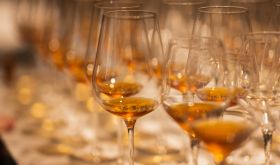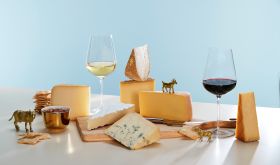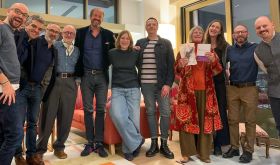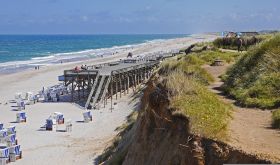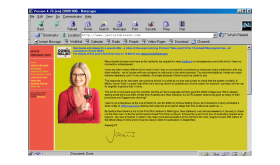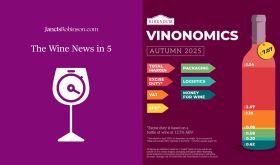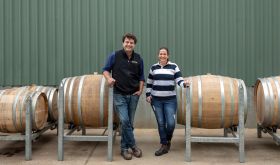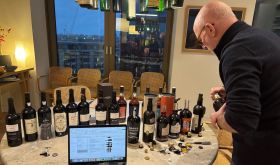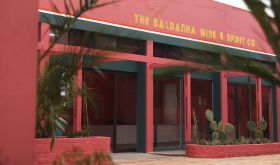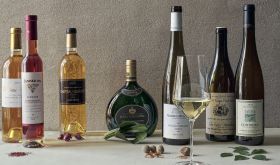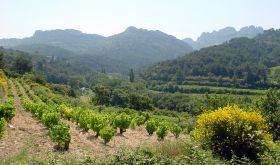14 March 2017 See also Richard’s review of Austria’s indigenous reds.
Last August I tasted all the 2015 Erste Lage wines produced by the members of the Traditionsweingüter in the regions in which this private association has members – Kamptal, Kremstal, Traisental and Wagram. The big Austrian tasting in London last month gave me the chance to focus on other regions, mainly the Wachau and Styria, with a few wines from the Thermenregion and a run of Roter Veltliners from Wagram. And at the end of the article below are my notes on the Ebner-Ebenauer wines from the Weinviertel that winemaker Marian Ebner happened to send me prior to the London event.
The wines were mostly from the 2015 and 2014 vintages, with a handful of older wines such as Domäne Wachau’s 1997 Kellerberg Riesling Smaragd reinforcing how well Austrian whites can age. There were also a handful of 2016s.
It always surprises me that the Wachau wine region, a UNESCO world heritage site, is so small (1,350 ha/3,336 acres, less than 3% of Austria's total vineyard area) when it has so much recognition and may well be the first Austrian wine region wine lovers think of when asked about the country. Its terraces are particularly dramatic, as seen in the photo above of the Achleiten vineyard (courtesy of AWMB/Gerhard Trumier), and the vineyards are dominated by Riesling and Grüner Veltliner, as reflected in the notes below. For an explanation of the classification system used by the private growers’ association Vinea Wachau – Steinfeder, Federspiel and Smaragd – see this entry in the online Oxford Companion, and see the Vinea Wachau website for a detailed interactive vineyard map of the region. There were some stellar wines here among the 2014s as well as the 2015s, though I have a feeling that the most successful 2014s, such as Pichler-Krutzler’s Loibenberg, may well age longer than their 2015 counterparts.
Südsteiermark (southern Styria), bordering Slovenia, has 2,340 ha (5,780 acres) of vineyard and the varietal mix is completely different from that of the Wachau: Sauvignon Blanc dominates and the other main varieties are Muskateller, Weissburgunder, Morillon (Chardonnay) and Riesling. Although my general tendency is to prefer indigenous to international varieties, this tasting reminded me of how exciting and distinctive Styrian Sauvignon Blanc can be: complex, mineral and, in some instances such as Manfred Tement’s single-vineyard Zieregg and Grassnitzberg bottlings, seriously ageworthy. Eric and Walter Polz’s excellent Grassnitzberg confirms what a great vineyard this is for Sauvignon Blanc. The Styrians also have their own classification system (for more on this knotty topic, see Austria wrestles with vineyard classification), with 1 STK equating to Burgundy’s premier cru and G STK to grand cru (STK stands for Steirische Terroir & Klassik Weingüter).

Among the wines from Thermenregion and Wagram, I reverted to type and focused on indigenous white varieties, mostly Roter Veltliner (no relation of Grüner) from the latter and Rotgipfler from the former, which is its place of origin. Both produce wines that tend to have riper fruit flavours and be more mouth-filling than the majority of Rieslings or Grüners, giving powerfully satisfying flavours.
The Ebner-Ebenauer wines represent an impressive if very selective picture of the Weinviertel, which is such a big area (13,356 ha/33,000 acres under vine) that it is hard to define a specific style for its dominant variety Grüner Veltliner, although an attempt has been made to do this via the awarding of the DAC classification for this variety back in 2002, which specifies the following taste profile: ‘aromatic, spicy, pepper notes, no botrytis, no oak notes’. The DAC Weinviertel Reserve, awarded in 2009, on the other hand, should be ‘dry, full-bodied, subtle botrytis notes and oak ageing allowed’. Ebner-Ebenauer choose to use the much bigger Niederösterreich designation – which encompasses the better-known names such as Wachau, Kamptal and Kremstal – for almost all their wines, mainly because there is greater immediate recognition of the name, especially on export markets, but also because the Weinviertel has yet to establish a reputation for top-quality wines. However, as winemaker Marion Ebner says, this is not the reality on the ground: 'If you desire to work without any compromise then you also have the chance to make beautiful wines', adding that it is getting better and better – 'there are some lights in the sky'.
A look at these different regions and their specialities highlighted the fact that there are very strong regional identities within Austria. It may seem that I am stating the obvious but a typical focus on Austria’s two top white varieties – Riesling and Grüner – on wine lists, for example, might sometimes obscure this diversity and not do justice to the depth and strength of Austria’s perfectionist and locally patriotic producers.
The 84 tasting notes below are grouped by region and then alphabetically by producer (sur)name but you can re-order as you wish.
WACHAU
RS 3.5 g/l, TA 5 g/l. Richer and spicier on the nose than the Rotes Tor. The sweetness adds to the full body and mouth-filling texture. Again there's pear fruit but also a light note of a riper flavour, perhaps apricot, that is hard to pin down, and definite white-pepper aroma and flavour. Lots of apricot aroma in the empty glass. (JH)
RS 1.4 g/l, TA 5 g/l. Subtle pear fruit and just a touch smoky. The acidity is relatively gentle but sufficient for the depth and richness here – surprisingly rich for a Federspiel. Some spice on the palate and a lovely creamy texture. (JH)
RS 6.3 g/l, TA 6 g/l. As on the Steinterrassen, a lightly mineral first impression. But also lovely ripe citrus, ripe lemon and spice. Excellent freshness to balance the richness of the fruit and a pure citrus finish. (JH)
RS 3.4 g/l, TA 6.9 g/l. Lightly smoky and mineral. Bright citrus and terrific fresh tension on the palate, with the fruit ripeness to clothe it and fantastic length. (JH)
RS 1 g/l, TA 5.9 g/l. Fresh peppery citrus aroma with a fine dusty/stony overlay. So mouth-watering and zesty on the palate. Tight and dry and really piercing. Great finesse and refinement. (JH)
RS 1 g/l, TA 5.9 g/l. Less primary fruit aroma here compared with the Kreutles Federspiel and more spicy minerality. Almost chewy in texture. Power and drive without any excess weight. Really intense on the mid palate and excellent length. (JH)
RS 3.4 g/l, TA 5.8 g/l. Aromas are a little more developed than on the 2013 with just a hint of kerosene but also honey and citrus and peppery spice. Even more depth than on the 2013, a little richer and still finishes fresh, chewily satisfying. (JH)
RS 5.8 g/l, TA 7.3 g/l. The note of honeyed citrus does not dominate the more stony mineral aroma but there's also a creamy lees note. Great intensity and freshness balanced by a slight grip in the texture. (JH)
Delicate dusty citrus. Then a strike of intense citrus on the palate. Pure and zesty and finishing with stony finesse. (JH)
This vineyard is on the border of Kamptal and Wachau, which is why it has to be labelled Niederösterreich not Wachau.
Very different aroma from the Loibner Federspiel – less citrus and more smoky, not sure if it is a little reductive or if it's the fumy character of wild ferment but it adds complexity for sure. Tastes drier than you might expect for Kabinett. (JH)
Most of the Malat wines are from the Kremstal DAC but here the vines are in the Wachau. RS 1.4 g/l, TA 5.9 g/l.
Fresh apple and pear fruit. Delicate, scented and beautifully fresh. The freshness seems to be intensified by a slight firmness in the texture. Persistent too. (JH)
RS 3 g/l, TA 5.8 g/l. Complex aroma of spice and lemon/orange and a creamy lees note. Really quite savoury on the palate, creamy texture and really savoury, with a fine grain. Very very long. Highly distinctive. (JH)
RS 6 g/l, TA 4.9 g/l. Like the Im Weingebirge Grüner, lots of spice. Full and creamy with lovely rich pear flavours and pear grain. Deep and satisfying. (JH)
RS 3.3 g/l, TA 6.2 g/l. Intense and almost peachy on the nose. Sour freshness on the palate, with a little note of orange. Botrytis? Spicy freshness on the long finish. Really mouth-watering and already complex. (JH)
Smells more honeyed and oily than the Steiner Hund (oily in a good way). Tight and fresh but seems just a touch more dilute on the palate than the Steiner Hund. Still has great length. (JH)
RS 5 g/l, TA 6.2 g/l. Seems very restrained on the nose. Just a hint of spice, but with air it shows layers of honey and citrus and a floral quality. Still so amazingly fresh and youthful, as if it were in a time warp. Piercing freshness. (JH)
RS 1.5 g/l, TA 5.9 g/l. Leaner than the 2015, more piercing and less texture but still with great length and intensity. Packed with flavour but in a more austere style than the 2015. (JH)
Mainly loess and flatter vineyards. Tank fermented. Earlier harvested.
Peppery lemon and lime. Zesty, bright and light. Easy-drinking style but still with finesse and a stony aftertaste. (JH)
Tank fermented. Still plenty of citrus but a little more creamy than the Frauengarten. Definitely creamy and more savoury/spice on the palate. More interesting texture too, the acidity giving a fine mouth-watering length. (JH)
Slightly higher vineyards (250-300 m) and more limestone in the soil. Fermented in large Stockinger oak.
Terrific spicy intensity on the nose, power and spice on the palate, with a firm grip suggestsing some skin contact. A big wine but still with the freshness to balance. Deep and tangy. Great length. (JH)
Very difficult to describe this complex aroma. Spice, citrus but also an 'oily minerality' and perhaps a note of quince. Mouth-watering purity and focus that is classic for the vintage and done beautifully here. Precise and long, intense citrus goes on and on at the end. (JH)
More straightforward and obvious fruit compared with the Loibenberg 2014. And much richer, sweeter tasting, on the palate. So different from the Loibenberg 2014. Much riper, and at the moment the fruit sweetness and acidity seem to be not fully integrated. Peachy finish. (JH)
About 12 hours' skin contact.
So different from the Frauenweingarten 2016. Richer, riper fruit aromas and that glorious spicy minerality that is so Austrian/Central European. Rich and creamy in texture, hard to believe this was tank fermented with that creamy texture – lees effect, perhaps? Gentle but long finish. (JH)
Their entry-level Grüner. Fermented in tank with just 3-5 hours' skin contact.
Classic varietal character, tight, fresh citrus and a light peppery character. More peppery on the palate. This is the first 2016 I have tasted and it bodes well. Excellent persistence. (JH)
A little smoky at first. Honeyed citrus on the nose then super-fresh on the palate. Extremely precise with a focus on the fruit, but not simple thanks to the stony and mouth-watering finish. Much leaner than the 2015 but not in the least thin. A wine for acid lovers and food. (JH)
Delicate fresh lemon fruit. Pure and zesty. Very primary but finishes dry and elegant and much tighter than many 2015s. (JH)
Oily mineral spice on the nose. Complex and rich but with terrific freshness under all that complex spice. A great combination of citrus, almost limey, purity and that complexity of bottle age. (JH)
Just a hint of development here but there are only a few cases left, apparently. The 2015 is sold out and the 2016 is still fermenting. Has the mouth-watering freshness of 2014 and extreme precision on the palate. Still so young and citrusy. (JH)
65-year-old vines. Fermented in 840-litre oak. RS 1 g/l, TA 5.7 g/l.
Much more complex than the Liebedich, with spice and a much more creamy texture. Caressingly smooth and rich in the mouth but still with excellent freshness. Extremely moreish and elegant, the freshness building on the finish. More to come. (JH)
Entry-level from a flatter vineyard. Mostly fermented in tank, one big cask.
Super-fresh for 2015, tight bright citrus with some white pepper. (JH)
His highest vineyard at 450 m. Half in stainless steel, half in acacia wood.
Already showing a honeyed richness but also piercing freshness. Great balance, especially in this riper vintage. (JH)
Early harvest of the non-botrytised grapes, therefore high acidity balanced by residual sugar. Low alcohol means it is considered a table wine.
Tastes sweeter than a Kabinett style but balanced. Lemon cream and gentle. A bit simple at the moment but should become a good deal more interesting – or would be good to tone down spicy food. (JH)
RS 2.1 g/l, TA 5.8 g/l. Riper and not quite as open as the Terrassen. Clear notes of the variety's signature white pepper with lemon/lime freshness. On the palate, more persistence than intensity, lacking a little depth on the mid palate. Really rather gentle. (JH)
RS 1.8 g/l, TA 5.4 g/l. Intense and ripe fruit aromas, yellow plum, citrus and almost peachy, spice too. Full and spicy in the mouth. As with many 2015s, a little more breadth and length than depth on the palate. Elegant and fresh. (JH)
'One of the best vintages in the last 30 years, along with 1999', apparently.
Deliciously honeyed and spiced on the nose. With age this has become much more savoury and there's a power behind the refinement. Lots of spice and sour minerality on the aftertaste. (JH)
RS 1.6 g/l, TA 6.1 g/l. Delicate aromas – a little peppery but also citrus and possibly a touch of blossom. Really fragrant. Stony and fresh on the palate. Super-dry and on the lighter side but persistent. (JH)
RS 3.5 g/l, TA 7.3 g/l. Already a little honeyed on the nose but fragrant like wild-flower honey rather than sweet. Lovely purity in this softer vintage, with the crisp finish adding length. (JH)
RS 1.8 g/l, TA 8 g/l. Bright stony citrus aroma. Attractively lightly smoky on the palate, either the terroir or a touch of reduction? A herbal note adds complexity. Impressive depth and length but still keeps the classic Riesling tension. (JH)
RS 1.6 g/l, TA 5.4 g/l. Just bottled.
Very expressive dusty, peppery pear fruit. Showing its extreme youth. Unexpectedly gentle on the palate but has surprisingly good length. Give it another six months to settle. (JH)
RS 12 g/l, TA 7.2 g/l. Already showing a honeyed character on the nose. Honey and lemon and quite a bit of residual sugar, though it is balanced. A little simple now but intense enough to suggest greater promise. (JH)
SÜDSTEIERMARK (SOUTHERN STYRIA)
This is from wines planted by Manfred Tement on the Slovenian side of the border, just 200 m from their Zieregg vineyard in Austria. Fosilni Breg means 'fossil mountain'. 100% large oak and unfiltered.
On the nose, not immediately obvious as Sauvignon Blanc. Seems much more site than variety, with an oily spice of Central Europe and only a light herbal quality. More herbal and tangy on the palate, but with a fine smoky mineral persistence. This is how Sauvignon Blanc should be, with real complexity and site character. Gentle lees creaminess balances all the zesty freshness. VGV (JH)
Less expressive than the Jakobi but much more interesting on the palate: more smoky and reductive in style, highlighting the site not the variety. An almost savoury quality to the sour-fresh finish and very long. Very intense. (JH)
Herbal, lively and fresh, but less distinctive than some. Has green fruits and just a touch of stony dryness on the finish. Much more interesting than a more pungent Sauvignon Blanc but quite straightforward. (JH)
RS 1.1 g/l, TA 6.5 g/l. Sophisticated and restrained oak on the nose – mealy and a touch of orange. Lightly smokily reductive too. Very crisp acidity. Quite a contrast between the rich texture and the piercing freshness. Needs time but has promise. (JH)
This is classified as Erste STK Lage (ie premier cru) in the Steiermark's vineyard hierarchy.
Not as immediately expressive as the Klassik, more mineral and herbal. Bone dry but with a fruit sweetness on the mid palate that balances the intense freshness. Very good. Long too. Utterly mouth-watering. (JH)
This is classified as Grosse STK Lage (ie grand cru) in the Steiermark's vineyard hierarchy. Limestone soil, fermented in bigger used oak. RS 3.4 g/l, TA 5.9 g/l.
Like the Therese but more so, that lovely smoky wild-ferment/reductive character. Under that smokiness there's subtle but fresh fruit, more herbal than citrus. Pure and precise and long. Very sophisticated Sauvignon. In the frame of Dog Point Section 94 but more delicate. Intensely sour freshness on the finish. Still so incredibly youthful. (JH)
Very herbal and expressive with a light smokiness (partial spontaneous ferment). Lovely bright green fruit backed with lemon/lime citrus. Cool, bright and zesty but that smokiness adds another dimension. Distinctive style for Sauvignon Blanc. (JH)
This is classified as Erste STK Lage (ie premier cru) in the Steiermark's vineyard hierarchy. Warm site but with cool marl soils. Fermented in 1,000-litre foudres. 18 months on lees. RS 1.3 g/l, TA 5.9 g/l.
A seductive ripeness of fruit here – lemon with a touch of orange – and creamy oak generosity on the palate. A spicy, complex Chardonnay that is entirely its own – does not try to mimic any other origin. There is spice and depth and still great freshness. Firm and savoury on the finish. Fabulous wine that is complex, fresh and long. (JH)
Blend of Pinot Blanc and Chardonnay. Now they tend to make varietal wines as the vines are older.
Has this glorious smoky, fumy nose of site and wild ferment. Very much a wine of its site but also a wine of the moment in terms of style. Complex, fresh and long. The varieties seem largely irrelevant as this is a terroir wine, well made to highlight the vineyard. (JH)
This is classified as Erste STK Lage (ie premier cru) in the Steiermark's vineyard hierarchy. Oldest vines, planted in the 1950s on limestone. A cool site. One year in big old Austrian oak. RS 1.9 g/l, TA 6.5 g/l.
There's citrus intensity here but also a herbal and smoky character. Relatively restrained on the nose and spicy. Fabulous intensity on the palate but it is pure and precise; not the pungency of the most extreme NZ Sauvignons, not as over the top, but just as intense in a more terroir-driven style. Superb restraint and intensity at the same time with just the right amount of fruit sweetness coming back on the finish. (JH)
Their 'village' wine. Clay/marl. One year in big oak (Austrian oak seasoned for 10 years). Unfiltered. RS 2.1 g/l, TA 6.1 g/l.
A light smoky nose with perfectly precise fumey wild-ferment character, possibly a little reductive. But that winemaking style really enhances the mineral stony character of the wine. Intensely mineral but still has the fruit to balance even if there is no specific fruit flavour. Very very long. Great wine, great terroir. (JH)
This is classified as Grosse STK Lage (ie grand cru) in the Steiermark's vineyard hierarchy. RS 2 g/l, TA 6.6 g/l.
This just shows how the Zieregg Sauvignon turns into something even more glorious with time in bottle. Lovely smoky, struck-match aroma that shows all the lovely complexity of wild ferment, old oak and reductive winemaking. Stunning. Has all the elegance and refinement of grand cru burgundy with the freshness and minerality of Styrian Sauvignon. The oak seems to emerge more with time, giving a richer and deeper wine. Just coming into its own. (JH)
This is classified as Grosse STK Lage (ie grand cru) in the Steiermark's vineyard hierarchy. South side of the coral reef, bigger shell fossils than in Chablis. Ferment starts slowly. Up to 24-30 hours on skins, depending on the temperature of the berries at harvest.
Cool green fruits on the nose. Incredibly tight and very high acidity, really piercing in its intensity with very direct, stony, citrus flavours. Pretty severe at the moment but glorious potential, as the 2011 shows. Wait – much too tight for now. (JH)
55 vineyard parcels, mainly limestone. 80% in tank, 20% in foudres with spontaneous ferment. Vinolok glass closure for all the Tement wines.
A contrast with the Domaine Ciringa Slovenian wine. More expressive with lemony herbs and still an attractive stony quality. This is amazing quality for a Klassik. Refined and persistent. (JH)
RS 1.7g/l, TA 6.4 g/l. After the Tement Sauvignons just tasted, this seems super-grapey but also seems to have a zesty Sauvignon Blanc streak. Juicy, full-fruited and with a fresh, almost sour (in a good way) finish. Tangy and long. (JH)
RS 1.8 g/l, TA 6.5 g/l. Restrained but still aromatic. Terrifically pure fruit but not pungent. Intense grassy green fruits. Primary and intense. Impressive concentration and still very fresh for 2015. (JH)
THERMENREGION
They call it Rheinriesling to distinguish it from the Klassik Riesling. This is also on a limestone vineyard in Gumpoldskirchen but late harvested and longer on the lees. RS 37.2 g/l, TA 6 g/l.
Complex spicy citrus. Much richer and fuller in the mouth than the Klassik but it tastes drier than the analysis suggests. Really rather gentle but very long. Needs time to gain complexity though the balance is there already. (JH)
Limestone soils. RS 3 g/l, TA 5.3 g/l.
Pure, lightly smoky Riesling aroma. Tight, smoky and very precise, especially for 2015. A very mineral style and good length. Sophisticated. (JH)
50% fermented in big oak, six months on lees. RS 1.2 g/l, TA 5.6 g/l.
The first Rotgipfler of the day and showing some lovely ripe and creamy fruit. The lees influence adding a notable richness on the nose. The oak shows too but it is cool and fresh and the contrast between that initial creamy quality and a sour freshness on the finish makes a lovely whole. (JH)
The older vines from the Rodauner vineyard, one year on lees and 30% new oak. RS 3.7 g/l, TA 4.8 g/l.
On the nose the oak influence seems very moderate. On the palate it is much more evident, and for me a little too much. It is a refined, oaky wine but the variety is not so easy to distinguish. I think it will get more interesting as the oak recedes. (JH)
50% Rotgipfler, 50% Spätrot (a synonym for Zierfandler). Spontaneous ferment in tank. RS 5.4 g/l, TA 5.5 g/l.
Lovely ripe fruit – yellow plum and yet still fresh. Full in the mouth. Creamy texture, very satisfying and still so fresh even with the riper fruit flavours. (JH)
From the Harterberg vineyard. Spontaneous ferment in second-fill oak. RS 2.4 g/l, TA 5.5 g/l.
A hint of oak on the nose. Powerful and spicy on the palate. That ripe, orchard-fruit flavour is there again as in the other Rotgipflers but there's great depth and richness of fruit here without loss of freshness. Sour/fresh finish. (JH)
8% fermented in used oak, of which 50% is acacia. RS 4.9 g/l, TA 6.4 g/l.
Not particularly intense on the nose but cool and fresh. More peachy than citrus but with very good acidity so that the residual sugar does not show. Freshness gives good length. (JH)
100% Gewürztraminer although the label does not specify that it is the aromatic mutation of the variety, fermented in steel. RS 14 g/l, TA 5.9 g/l.
Classic varietal fragrance. Lovely perfume without being over the top. A very fresh style of Gewürz but absolutely classic aromas and flavours in a restrained style. Tastes drier than it is but it is definitely not dry. (JH)
60% Zierfandler, 40% Rotgipfler. This is the classic blend of the region. RS 14 g/l, TA 6.1 g/l.
A bit fatter and spicier than the straight Rotgipfler but still with great freshness. A range of fruit flavours from crisper citrus to richer yellow plum. Great length. (JH)
RS 3 g/l, TA 6.1 g/l. Honeyed-pear richness on the nose. Lovely depth of fruit and still very fresh, with a hint of orange on the palate. Almost chewy in texture and a mouth-watering finish. Lovely to have so much depth with such moderate alcohol. (JH)
RS 8.5 g/l, TA 7 g/l. A light creamy overlay on the nose then generous fruit on the palate. Ripe citrus and really tangy yet there is weight here too. Satisfying and rounded on the finish. (JH)
RS 3.9 g/l, TA 5.4 g/l. This wine really shows the honeyed character of the variety. Fat, spicy and smoky, though it is almost more like burnt rubber than smoke. A bit harsh/bitter on the palate. (JH)
WAGRAM
Haide is a part of the Eisenhut vineyard. Fermented in tank with selected yeasts. RS 6.4 g/l, TA 6 g/l.
Has the marked honeyed character of the variety. Yellow plum and fruit sweetness but terrific freshness. Delicious. Creamy texture. (JH)
The same fruit as in the Haide but here with three weeks on skins. Nine months in new French oak.
Pale orange colour. Gorgeous aroma: apricots and oranges and still the honeyed character of the variety. Fabulous texture – tannic but not astringent, with a rounded, honeyed finish. A lovely wine that you could drink with or without food, unlike many skin-contact whites which tend to need food. Sour-apricot finish. Great length. (JH)
Creamy lemon and peach nose but also a ripe fruit character and a creamy quality. The zest of quince too. On the palate, fuller and richer than a Grüner Veltliner (the varieties are not in fact related), and quite peachy in flavour. Then tightens up to a long, fresh finish. (JH)
This is the first vintage he has released this as a single-vineyard wine.
Less immediately expressive than the Klassik but you can sense a greater depth. Yellow plum, lovely fruit sweetness allied to fresh acidity. Terrific intensity and varietal purity. The richness of the variety and the freshness of a higher-elevation site (c 400 m). (JH)
This wine is normally labelled as Scheiben but they lost about 80% of the crop due to hail and they had to use the best fruit from all their vineyards. Tiny volumes made, sadly.
Creamy/mealy texture, creamy ripe yellow-plum and apricot fruit but still with lovely freshness. Fuller in the mouth than the Fumberg but may not last as long – difficult to know without having tasted older vintages with more bottle age. (JH)
WEINVIERTEL (EBNER-EBENAUER)
Loess soil from two vineyards in the village of Poysdorf. Harvested late September. 10 hours’ cold soak. Their only Grüner to be fermented with selected yeasts. Three months on lees in tank. RS 1 g/l, TA 7.4 g/l.
Pure and rather delicate on the nose but a definite stony spice note with a hint of apple and pear. On the palate, this is very similar, with notable spice increasing the freshness of bright lively acidity. Perhaps a little more green fruited on the palate, zesty green apple. Classic, straight-shooting Grüner but with very good persistence in a linear way even though the flavours are subtle. (JH)
From the Birthal vineyard in Poysdorf, sandy soil. Harvested 20 October. Spontaneous fermentation. 3 months on lees in tank. RS 1.1 g/l. TA 6.7 g/l.
Smells just a little riper than the Grüner labelled Niederösterreich but with the same spicy, stony quality rather than intense fruit aromas. Pear more prominent here along with classic white pepper. Still more mineral than intensely fruity. On the palate, the fruit comes more to the fore, a little richer and more rounded and the acidity tasting slightly softer, the wine a little fuller in the mouth but seems more a different style than a step up in quality from the Niederösterreich wine. A little more intensity but not more persistence. (JH)
Single-vineyard wine from Poysdorf, all vines 30+ years old. Loess soil with limestone, steep and south-facing. Harvested 15 October. Spontaneous fermentation. Six months on lees in tank. RS 1.1 g/l, TA 6.4 g/l.
Riper fruit aromas here with green fruits, citrus and even a little bit peachy. Smells somehow creamy too. Still beautifully fresh and lightly spiced but fuller in the mouth. Bone dry yet seems quite gentle thanks to the depth of fruit even with this much acidity. Moderate length and a fine balance of fruit depth and freshness. (JH)
Single-vineyard wine from Poysdorf, all vines 50 years old. On a plateau with heavy loam soil. Harvested 20 October. Spontaneous fermentation in 500-litre barrels and small steel tanks. RS 7.4 g/l, TA 5.7 g/l. Bottle shape changes here to burgundy from taller flute for the previous wines.
Richer and more intense spice, more of an oily mineral spice than the classic white pepper of Grüner. Deep and spicy on the palate too, though I would not have guessed at this much residual sugar if I had tasted this blind. It is rich but still beautifully fresh and with power and length. (JH)
Single vineyard on loam soils and gravel, planted in the early 1960s on a plateau. Harvest 28 October. Spontaneous fermentation in 500-litre barrels and small steel tanks. RS 3.5 g/l, TA 5.9 g/l. Burgundy-shaped bottle but still with screwcap.
Ripe, spicy pear aroma. with a stony, peppery intensity alongside the richness of fruit. There’s pear and citrus and even a touch of just-ripe apricot here, though it tastes dry. Concentrated and complex, deep and long. Fabulous intensity without loss of freshness – the citrus notes kick back in on the finish. The old vines really showing their character in this effortless depth of fruit and spice and excellent balance. Dry-tasting, taut and fresh but rounded on the finish thanks to the barrels. The oak is still very much a restrained support compared with the more obvious oak on the Black Edition. (JH)
From the Von der Luessen vineyard on slate and loess soils, planted early 1960s. Harvest end October. Spontaneous fermentation in 500-litre barrels and small oak barrels (30% new). RS 2.4 g/l, TA 5.5 g/l. Burgundy-shaped bottle but still with screwcap.
This is spicy like the Sauberg and the Bürsting but more savoury on the nose, more creamy. A more definite leesy, creamy quality, perhaps thanks to the percentage of new oak. Powerful, deep and spicy with the added richness of the oak though there is very little oak flavour. Impressive intensity and length and still fresh, though a little less so on the finish compared with the Sauberg. (JH)
Like the Black Edition Pinot, this is in an unnecessarily heavy bottle with a front label that is almost impossible to read. Sealed under cork, with a wax seal. From the Maxendorf vineyard on loess. 48 hours on skins. Spontaneous fermentation and 12 months’ ageing on lees in French oak barrels. Lees stirring daily for first three months and then once a week. TA 5.8 g/l, RS 8.2 g/l.
Smells of spicy, fresh, ripe pears, you can almost smell the pear graininess. Here the oak is more evident with some vanilla on the nose and richly textured and creamy on the palate and still finely balanced even with this level of residual sugar. This has both fruit and a mealy/savoury quality, depth and complexity. Terrific intensity and length. (JH)
From the Alte Geringen vineyard on loess with limestone. Planted late 1950s. 72 hours on skins, four months in tank on lees. RS 5.7 g/l, TA 5.8 g/l.
This is really quite spicy on the nose with an attractive dusty/chalkiness. The skins and the lees have given this a lovely grainy texture and a richness in the mouth that is more about texture than fruit flavour. Firm and chewy and tastes pretty dry – I imagine the little bit of residual sugar softens the phenolics from the skin contact. A very mineral and spicy style. Satisfying and food-friendly. As it warms up a bit, the fruit starts to emerge, with pear and citrus freshness. Should age well. A baby now but still masses of pleasure. (JH)
From the Steinbergen vineyard planted on gravel alluvial soils. Vines aged 65 years. 20% botrytis-affected grapes are vinified separately, and Auslese ripeness levels. Fermented and matured in tank. RS 9.6 g/l, TA 7.1 g/l.
Intense fruit aroma that encompasses limey citrus, clementine and just-ripe apricots as well as a light note of spice. Beautifully balanced on the palate between zesty fruit, that touch of sweetness and crisp acidity. More stony and a touch of spice on the finish, which is intensely fresh. Rich in the mouth, almost chewy. A baby that needs more time for the sweetness/acid to be further integrated and for the flavours to become more complex. (JH)
Like the other Black Editions, the ‘front label’ is unreadable (black text on black) and the bottle unnecessarily heavy. Wax seal. 72 hours on skins, spontaneous fermentation and then aged in French oak with daily lees stirring for the first three months, then weekly. On lees for 12 months.
Very ripe, exotic fruit aroma. Stone fruit and papaya and clementine. Rich and zesty on the palate, great freshness with really ripe fruit. Anything less like burgundy would be hard to imagine, unless it was Thévenet. The fruit is so rich that the oak barely shows except in the richness of the texture and a light savoury/mealy aroma that emerges after the fruit. Rich, juicy and mouth-filling. Not sure I would know this was Chardonnay if you served it to me blind. The producers suggest pairing it with roast beef or fillet steaks as well as grilled fish, spicy hard cheese. I’d have to taste it with beef to be convinced. (JH)
Fifty-year-old vines. This variety – the non-aromatic version of Savagnin Rose – has a long history in the region as an alternative to the typically lighter/fresher Grüner Veltliner. Fermented in steel and kept on lees until May 2016 before bottling in August. RS 30 g/l.
Spicy and ripe-fruited. A very complex wine already with a savoury, rich texture, plenty of both sweetness and freshness and a tapestry of flavours that are not easily taken apart though there is something both exotic and savoury to this. Sweet but the texture makes it taste rather dry. Very long. They describe it as ‘baroque’! (JH)



